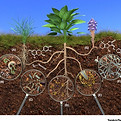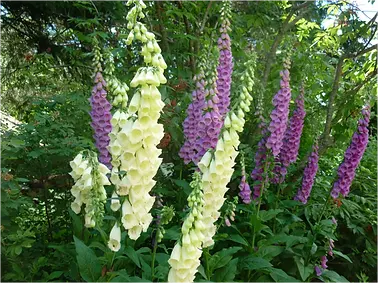
Our Seedpods & Seedboxes
What's a Seedpod?
A Seedpod is more than just a capsule, it's a concentrate of plant potential.
Inspired by the Fukuoka method and advances in agroforestry, we've designed our Seedpods to mimic plants' natural germination mechanisms and maximize germination rates. Each Seedpod encapsulates several seeds, combined with essential nutrients, to give young plants a robust start. Like a protective cocoon, each Seedpod recreates the ideal conditions for life to take root, for efficient, natural vegetation.
Like a protective cocoon, the Seedpod creates an ideal microenvironment for germination, enabling young shoots to take root in the soil over the long term. It thus modernizes the natural seed dispersal process, while increasing the effectiveness of ecosystem regeneration.

Why opt for the Seedpod?
Seedboxes are the ideal solution for fast, efficient and resilient planting.
Each Seedpod contains the optimum number of seeds, surrounded by a nutritious substrate that ensures successful planting, even in difficult conditions. Assembled in a Seedbox, they can be used to seed large areas while promoting local biodiversity.
The germination stage is critical and depends on many factors: soil moisture, fertility, germ fixation... Our Seedpods overcome these challenges by providing an optimized microenvironment, which maximizes the chances of success and accelerates the growth of young plants.
Easy to deploy, Seedboxes enable mechanical seeding without the high costs of traditional planting—the result: a more accessible, faster and more efficient process.
The benefits of Seedboxes
-
Large-scale production: we manufacture Seedpods in volume, customizing their composition according to species and field conditions.
-
Fast, widespread seeding: ideal for restoring degraded ecosystems or revegetating large areas.
-
Easy to use: simply place or press Seedpods into the soil, with or without light clearing. No specialized equipment is required!
-
Diversified, sustainable approach: unlike monocultures, our Seedboxes encourage the complementarity of species, for more balanced, resilient ecosystems.
-
Reduced costs and carbon footprint: efficient seeding without heavy machinery or nurseries, and optimized transport thanks to their compact format.
Design & Composition
Our Seedpods are carefully formulated to maximize sowing success. They contain:
-
Seeds adapted to soil conditions and planting objectives.
-
Water-retention additives to improve seedlings' resilience to climatic variations.
-
Beneficial bacteria and fungi enrich the soil and stimulate root growth.
-
Essential minerals and nutrients for optimal development.
-
A natural stimulator that boosts germination and seedling vigour.
Thanks to automation and production optimization, we can manufacture these Seedpods in large quantities while minimizing their energy impact. Compared with traditional reforestation methods, our Seedpods reduce waste, logistics costs and the carbon footprint of transport.

This is taken into account when selecting the species that make up a Seedbox.
01.
Hardiness zone
Adapted to today's and tomorrow's local climatic conditions
02.
Strata of the forest
We select species from between 2 and 5 plant strata.
03.
Sought-after features
Selection suitable for flora, fauna and humans.
04.
Ground cover
For ecosystem management, shade and soil protection.
05.
Nature of the location
Les spécificités de la localisation tel que la composition du sol, l'humidité et autres caractéristiques spécifiques

Hardiness Zones
Understanding hardiness zones for a thriving ecosystem in Quebec
Hardiness zones, from 2a to 5b in the first half of Quebec, are key indicators for determining the composition of a Seedbox adapted to Quebec soil, determining which plants can survive the winter climate of each region.
Zone 2a
Extreme cold
This is one of the coldest zones, with winter temperatures reaching -45°C. The plants that thrive here are extremely resistant to cold and severe frost.
Ideal for hardy plants such as certain conifers and alpine plants.
Zone 3b
Biting cold
Still rigorous, this zone allows a wider variety of plants to be grown, including certain hardy conifers and shrubs, as well as perennials.
Zone 4a
Moderate cold
This zone is home to plants that require some winter protection but remain hardy.
With winter lows of -34°C, this zone allows a wider range of hardy plants to be grown, and opens the door to a variety of fruit trees and shrubs.
Zone 5b
Mild cold
Provides conditions for more cold-sensitive plants, increasing seeding options.
This is the mildest zone treated here, with temperatures as low as -26°C, allowing the cultivation of many perennials and even some of the more delicate fruit trees.

Attractions
Plants play fascinating and vital roles in sustaining life on Earth, positively impacting flora, fauna and humans alike. They help maintain the health of other plants by enriching the soil and stabilizing ecosystems, essential for a robust flora. Animals find food, protection and breeding sites in these plant environments, illustrating the importance of plants to the survival of wildlife. For us humans, plants are crucial not only for their beauty and ability to enhance our living environment, but also for their healing and nutritive properties, not to mention their role in construction and other commercial applications. In short, plants are at the heart of a prosperous coexistence between nature and humankind.

For the flora

For wildlife

For humans beings
In the great orchestra of nature, each plant has its own score. Nitrogen fixers enrich our soils without the need for chemical fertilizers, a true gift of nature. Champions of soil stabilization and erosion mitigation work silently to keep our precious land from eroding. Windbreaks aren't just practical; they're essential for protecting our gardens and fields from the elements. And what can we say about flowers, except that they bring color and joy to our lives while feeding bees and other beneficial insects? Pioneer plants lead the charge in regenerating our landscapes, and it's our responsibility to support endangered species, true treasures of biodiversity.
Imagine a green space where every plant is a superhero for different animals. Pollinators find their daily source of energy in these green heroes. Plants that charm butterflies offer them a sanctuary to feed and reproduce. The shrubs and flowers that attract birds and hummingbirds are natural service stations, brimming with nutritious food. By supporting these players in nature, we help the ecosystem as a whole, as these plants also provide food and shelter for many other animals. By choosing these plants, we contribute to a richer, greener world.
Plants offer a multitude of benefits that enrich our daily lives. They have recognized medicinal properties, and have been used for thousands of years to treat a variety of ailments, from simple coughs to more complex imbalances. At the same time, many species are edible, playing a crucial role in our diet with fruits, vegetables and herbs enriching our dishes with essential flavours and nutrients. Ornamental plants embellish our living spaces, bringing colour, life and serenity to our personal and public environments. In the face of environmental challenges, certain species are highly resistant to urban pollution, improving air quality and offering a haven of freshness in the city. Finally, commercial wood from certain plants is used to create furniture, tools and other structures, playing a significant economic role.

The 7 strata of the forest
The Quebec forest, a complex, living ecosystem, is made up of several superimposed strata, each with its own biodiversity and forming a complex, interdependent structure. On the forest floor, the layer of ground cover plants forms a green carpet, crucial for protecting and enriching the soil. Just above, pioneer plants, quick to grow and colonize open spaces, prepare the ground for more permanent species. The shrub layer, dense and abundant, provides an essential habitat for many insects and small animals. The trees of the lower tree stratum then begin to rise, creating a first layer of canopy that moderates light and tempers the underlying climate. Finally, dominating the landscape, the canopy stratum shelters the tops of the tallest trees, veritable towers of biodiversity that capture sunlight and play a key role in the water and carbon cycle. Each stratum is a world in itself, but together they form the vibrant harmony of our forests.
Seedpods





1 pioneer plants
4 low tree strata
6 strata Canopy
2 Shrub stratum
5 stratum Ground cover
Not available

*3 Rhizosphere stratum

*7 Stratum of Climbers

Composition of a varied plant cover.

1 Ground cover
Ground cover plants are ideal for stabilizing soil and reducing erosion. They form a dense carpet that inhibits weed growth and beautifies bare soil with little height. Some are also useful as pioneer plants to protect the soil and its rhizosphere layer after a forest fire.
2 Flowers and shrubs (<0.5m)
These little wonders adorn gardens with their vivid colors. Flowers, often annual or perennial, provide ephemeral beauty, while sub-shrubs are woody plants providing year-round structure.


3 Herbaceous (floral, herbaceous, grasses) (<1m)
Herbaceous plants include flowers with flexible stems, non-flowering herbaceous plants and grasses. Each type plays a crucial role in the biodiversity of an ecosystem, offering texture and color.
3 Vegetables
Essential to any vegetable garden, vegetables provide food and health. Cultivated for their fruit, leaves or roots, they are indispensable to human and animal nutrition.


5 Shrubs and bushes (0.5m - 4m)
These medium-sized plants are perfect as privacy screens or focal points in green spaces. Shrubs are lower, while bushes can reach up to 4 meters.
6 Trees (deciduous, fruit) (2m - 8m)
Deciduous and fruit trees add structure and shade, as well as tasty fruit. Their modest size makes them ideal for urban gardens.


6 Large trees (deciduous, coniferous) (8m - >15m)
These giants provide shade, wildlife habitat and majestic beauty. Conifers are prized for their evergreen foliage, and deciduous trees for their colorful seasonal foliage.

Nature of the location
Factors to consider
01
Soil type
From wet to dry, acidic to alkaline, calcareous to sandy, each soil has its own particularities and influences the selection of species.
02
Type of exposure
Sun, half-shade or shade. Each species loves the sun with varying degrees of moderation.
03
Current species
A site is home to a rich biodiversity, including native plant species, so judicious introductions of exotic species are essential. This plant diversity serves as a habitat for a multitude of animal species, creating a vibrant and dynamic biotope.
04
Particularities
Features such as slopes, rivers and naturally shaded areas create micro-environments that need to be taken into account.

Seedbox Coverage
Taille Seedbox Size | Couverture / Coverage | # Seedpods arbres / trees | Avr # Seedpods | Tonne CO2 capturé / ton captured |
|---|---|---|---|---|
5 Mega | approximately 5,000m or 53,820 square feet or linear feet or 0.5 hectares | 12500 | 135000 - 165000 | 215.77 |
4 XLarge | approximately 1,000m or 10,764 square feet or 0.1 hectare | 2500 | 27000 - 33000 | 43.15 |
3 Large | approximately 120m or 1,292 square feet | 300 | 3240 - 3960 | 5.18 |
2 Medium | approximately 30m or 323 square feet | 75 | 810 - 990 | 1.29 |
1 Mini | approximately 6m or 65 square feet | 15 | 162 - 198 | 0.26 |













